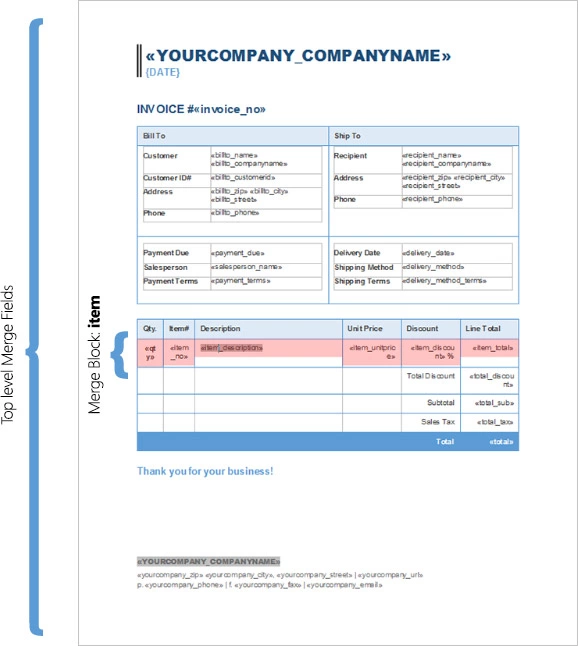ReportingCloud: The MergeData JSON Object Format Explained
When merging templates with data, a JSON object contains merge data for all merge fields and merge blocks in the document. Using the language specific wrappers, the JSON object is created automatically and you don't need to know the exact expected JSON structure. For example, the .NET wrapper accepts an object as data which is then transformed to the required JSON data implicitly. Consider the following .NET class: Now, an instance of that object is created and passed to the MergeData…

When merging templates with data, a JSON object contains merge data for all merge fields and merge blocks in the document. Using the language specific wrappers, the JSON object is created automatically and you don't need to know the exact expected JSON structure. For example, the .NET wrapper accepts an object as data which is then transformed to the required JSON data implicitly.
Consider the following .NET class:
public class Invoice
{
public string name { get; set; }
public string invoice_no { get; set; }
}Now, an instance of that object is created and passed to the MergeData property of the MergeBody object:
// create dummy data
Invoice invoice = new Invoice();
invoice.name = "Text Control, LLC";
invoice.invoice_no = "Test_R667663";
// create a new MergeBody object
MergeBody body = new MergeBody();
body.MergeData = invoice;In the MergeDocument method, the MergeBody object is simply passed as a parameter:
// merge the document
List<byte[]> results = rc.MergeDocument(body, templateName, ReturnFormat.PDF);Internally, the wrapper is creating the expected JSON format of the complete MergeBody object:
{
"mergeData": {
"name": "Text Control, LLC",
"invoice_no": "Test_R667663"
},
"template": null,
"mergeSettings": null
}The sample template, that gets copied into your template storage when creating a trial account, contains top level merge fields and a merge block that contains separate merge fields:

Top level merge fields are all fields in a template that are not part of a merge block. The complete template is repeated based on the number of records (array entries) in the merge data. Merge fields encapsulated in a merge block are repeated based on the number of merge block data rows in the JSON array. Additionally, merge blocks can be nested in unlimited levels. The following JSON data contains 1 top level record:
[
{
"yourcompany_companyname": "Text Control, LLC",
"yourcompany_zip": "28226",
"item": [
{
"qty": "1",
"item_no": "1",
"item_description": "Item description 1",
"item_unitprice": "2663",
"item_discount": "20",
"item_total": "2130.40"
},
{
"qty": "1",
"item_no": "2",
"item_description": "Item description 2",
"item_unitprice": "5543",
"item_discount": "0",
"item_total": "5543"
}
],
"total_discount": "532.60",
"total_sub": "7673.4",
"total_tax": "537.138",
"total": "8210.538"
}
]The data is part of an JSON array. The array contains 1 top level entry and this entry has two items in the merge block item. The following sample JSON structure contains 2 top level array entries that produces 2 resulting documents:
[
{
"yourcompany_companyname": "Text Control, LLC",
"yourcompany_zip": "28226"
},
{
"yourcompany_companyname": "Text Control GmbH",
"yourcompany_zip": "28217"
}
]Cloud
Are we moving to the cloud? This question is changing from "if" to "when" and "how". Text Control ReportingCloud brings complete reporting functionality to the cloud so all developers can use it, irrespective of the platform or language they're using. Its highly RESTful API can be used to merge Microsoft Word compatible templates with JSON data from all clients including .NET, Javascript, PHP, Node.JS, jQuery, Ruby, Python, Android, Java and iOS.
Related Posts
ReportingCloud: Uploading Templates Vs. Sending Templates Inside MergeBody
Our reporting Web API ReportingCloud provides two different ways to upload templates for merging processes: Upload templates into the template storage in a separate step Upload templates inside…
MailMerge: Table Headers and Repeating Blocks
When using table headers and repeating blocks in combination in a MailMerge process, there are some things you need to know before creating your templates. A table header can consist of n number…
ReportingCloud: Conditional Text Blocks Based on Merge Blocks
In several applications, it is required to render or to remove a complete text block in a template based on specific conditions. The following screenshot shows a template with a merge block…
Web API Test Sandbox Released on ReportingCloud Portal
We just released a Web API Test Sandbox at the ReportingCloud portal. This sandbox can be used to test Web API calls with your account data and your template storage (so not a completely isolated…
ReportingCloud: New Test Parameter for Document Quota Related Endpoints
The quota related endpoints merge, convert and findandreplace received the new, optional parameter test to send test calls that doesn't count against the document quota. This parameter allows you…

